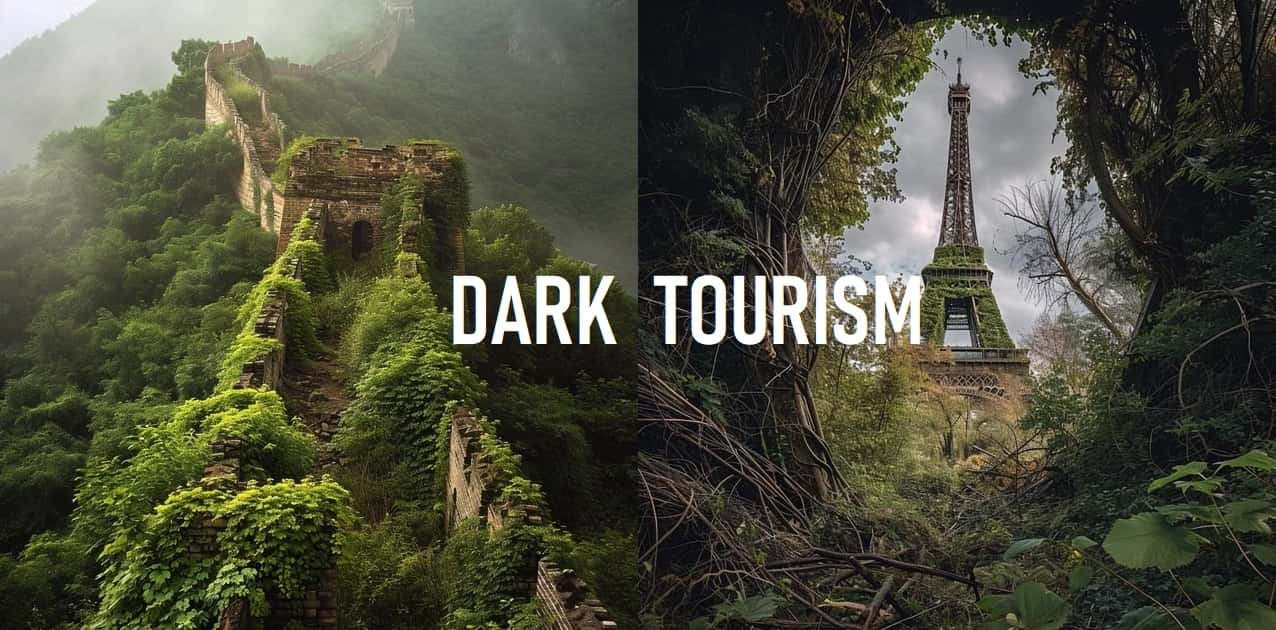Dark tourism, intriguing and controversial, delves into destinations associated with death, tragedy, or suffering, offering a unique lens to explore history’s darker chapters. Let’s shed light on this phenomenon and unravel its mysteries.
Key Takeaways:
- Dark tourism explores destinations linked to death, tragedy, or suffering.
- It’s called ‘dark’ due to its focus on macabre or somber aspects of history.
- Countries like Cambodia, Rwanda, and Germany are famous for dark tourism sites.
- The morality of dark tourism is debatable, with proponents arguing for educational value and critics expressing concerns about exploitation.
- Stakeholders benefiting from dark tourism include local communities, businesses, and heritage preservation initiatives.
- The aim is to educate, remember, and reflect upon significant historical events.
- The concept of dark tourism can be traced back to ancient times but gained modern recognition in the late 20th century.
- India also has sites like Jallianwala Bagh and Cellular Jail catering to dark tourism.
- ‘Grey tourism’ refers to visiting places associated with aging, illness, or end-of-life issues.
- Disadvantages include ethical dilemmas, potential desensitization, and commercialization of tragedy.
- The future of dark tourism may see continued growth but requires responsible management to balance education and respect.
What is Dark Tourism?
Dark tourism, sometimes termed thanatourism or grief tourism, involves visiting places connected to death, tragedy, or suffering. Rather than traditional leisure or relaxation, it offers a journey into somber historical narratives.
Why is it Called Dark Tourism?
The term ‘dark’ conveys the focus on macabre or somber aspects of history. These destinations often involve confronting themes like war, genocide, natural disasters, or crime, shedding light on humanity’s darker facets.
Which Country is Famous for Dark Tourism?
Several countries boast prominent dark tourism sites. Cambodia’s Killing Fields, Rwanda’s Genocide Memorials, and Germany’s concentration camps are notable examples. Each holds significant historical weight, drawing visitors seeking to understand past atrocities.
Is Dark Tourism Good or Bad?
The morality of dark tourism is subject to debate. Proponents argue it fosters education, remembrance, and empathy. However, critics express concerns about exploitation, sensationalism, and ethical considerations surrounding profiting from tragedy.
Who Benefits from Dark Tourism?
Various stakeholders benefit from dark tourism. Local communities may gain economic opportunities, while heritage sites receive attention and preservation efforts. Additionally, educational initiatives thrive, fostering understanding of complex historical events.
What is the Aim of Dark Tourism?
The primary aim of dark tourism is multifaceted. It seeks to educate visitors about significant historical events, remember the victims, and encourage reflection on the consequences of human actions. Ultimately, it serves as a platform for learning and understanding.
Who Started Dark Tourism?
While the concept of visiting sites of death or tragedy dates back centuries, modern recognition of dark tourism emerged in the late 20th century. Scholars like John Lennon and Malcolm Foley began exploring the phenomenon, leading to its contemporary understanding.
Which Country is Number 1 in Tourism?
The title of the number one tourist destination varies over time and depends on various factors such as infrastructure, attractions, and marketing efforts. Countries like France, Spain, and the United States often rank among the top contenders.
Why Do People Love Dark Tourism?
People are drawn to dark tourism for various reasons. Some seek to understand history’s darker chapters, while others are driven by curiosity or a desire for educational experiences. It offers a unique perspective on humanity’s past and encourages reflection.
Who Likes Dark Tourism?
Dark tourism appeals to a diverse audience. History enthusiasts, academics, and travelers seeking unconventional experiences are often drawn to these sites. Additionally, individuals interested in understanding cultural heritage and societal impacts find value in dark tourism.
What is Dark Tourism in India?
India boasts several dark tourism sites, including Jallianwala Bagh, the site of a tragic massacre during British rule, and Cellular Jail in the Andaman Islands, known for its grim colonial history. These destinations offer insights into India’s tumultuous past.
When Did Dark Tourism Start?
The roots of dark tourism trace back centuries, with examples like ancient Roman gladiator arenas drawing spectators. However, modern recognition of dark tourism as a distinct phenomenon emerged in the latter half of the 20th century.
What is Grey Tourism?
Grey tourism, a related concept, involves visiting places associated with aging, illness, or end-of-life issues. This includes destinations like hospices, nursing homes, or medical museums, offering insights into these aspects of human existence.
What Are the Disadvantages of Dark Tourism?
Despite its educational value, dark tourism poses several disadvantages. Ethical dilemmas surrounding profiting from tragedy, potential desensitization to suffering, and the commercialization of historical events are among the concerns raised by critics.
it’s clear that dark tourism is a nuanced and complex phenomenon that elicits a variety of reactions and motivations from different individuals. Let’s delve deeper into some key insights gleaned from these personal experiences and reflections:
- Motivations for Dark Tourism:
- While some are drawn to dark tourism out of a genuine interest in history and politics, others seek to understand extreme human experiences from a psychological standpoint.
- Historical and paranormal aspects often attract individuals to dark tourism, with a preference for experiences that lean towards the mainstream rather than extreme or dangerous activities.
- Personal Boundaries and Ethical Considerations:
- Many individuals express discomfort with certain aspects of dark tourism, such as visiting sites associated with recent tragedies or human suffering.
- There’s a distinction between seeking out historical or paranormal experiences and engaging in voyeuristic behavior that exploits others’ misfortune or poverty.
- Approaching dark tourism with the right attitude and respect for the significance of the sites can lead to valuable and moving experiences.
- Cultural Sensitivity and Respect:
- Acknowledging the importance of cultural sensitivity, some individuals refrain from certain dark tourism activities, such as visiting concentration camps or impoverished areas, out of respect for the victims or residents.
- Reflecting on the difference between historical sites like Civil War battlefields and more recent dark tourism destinations raises questions about the passage of time and the evolving perceptions of historical events.
- Balancing Curiosity with Responsibility:
- While dark tourism offers opportunities for immersive learning and understanding, it requires a delicate balance between curiosity and responsibility.
- Engaging with dark tourism sites should involve a thoughtful approach that acknowledges the gravity of the events and respects the memories of those affected.
In essence, dark tourism serves as a lens through which individuals confront the darker aspects of human history and psychology. While motivations and boundaries vary, a respectful and empathetic approach is essential for meaningful engagement with these complex and often somber destinations.
Dark tourism destinations encompass a wide array of sites around the globe, each with its own unique historical significance and cultural impact. Here’s a selection of some prominent dark tourism destinations:
| Destination | Description |
|---|---|
| Auschwitz-Birkenau, Poland | One of the most notorious Nazi concentration and extermination camps, symbolizing the horrors of the Holocaust. |
| Hiroshima Peace Memorial Park, Japan | Commemorates the atomic bombing of Hiroshima during World War II, offering poignant insights into the devastating effects of nuclear warfare. |
| Chernobyl Exclusion Zone, Ukraine | Site of the 1986 nuclear disaster, now a hauntingly abandoned area frozen in time, offering a glimpse into the consequences of technological failure. |
| Ground Zero, New York City, USA | Memorializes the September 11, 2001 terrorist attacks, honoring the victims and reflecting on the impact of terrorism on a global scale. |
| Killing Fields, Cambodia | Remnants of the Khmer Rouge regime’s atrocities, where mass executions occurred during the Cambodian genocide, serving as a somber reminder of the country’s tragic past. |
| Robben Island, South Africa | Former prison where Nelson Mandela and other political prisoners were held during apartheid, highlighting the struggle for freedom and equality. |
| Pompeii, Italy | Ancient city preserved in volcanic ash after the eruption of Mount Vesuvius in 79 AD, offering a glimpse into daily life and sudden tragedy in the Roman Empire. |
| Tuol Sleng Genocide Museum, Cambodia | Former high school turned prison and torture center by the Khmer Rouge regime, providing chilling insights into the horrors of the Cambodian genocide. |
| Pripyat, Ukraine | Abandoned city near the Chernobyl nuclear power plant, evacuated after the 1986 disaster, now frozen in time as a haunting reminder of nuclear catastrophe. |
| Srebrenica Memorial and Cemetery, Bosnia and Herzegovina | Commemorates the Srebrenica massacre, where thousands of Bosniak men and boys were killed during the Bosnian War, serving as a poignant reminder of the consequences of ethnic conflict. |
These destinations, while often somber and sobering, offer invaluable opportunities for education, reflection, and remembrance, inviting visitors to engage with complex historical narratives and the enduring legacies of human tragedy.
Dark tourism locations span the globe, offering visitors a chance to explore somber and historically significant sites. Here’s a diverse selection of dark tourism locations from various regions:
Europe:
- Auschwitz-Birkenau Concentration Camps, Poland: Symbolizing the atrocities of the Holocaust, these camps are a solemn reminder of the horrors of Nazi Germany.
- Chernobyl Exclusion Zone, Ukraine: Following the 1986 nuclear disaster, this area remains abandoned, frozen in time, offering a haunting glimpse into the consequences of nuclear catastrophe.
- Pompeii, Italy: Preserved by the volcanic ash of Mount Vesuvius, Pompeii provides insight into ancient Roman life and the sudden tragedy of natural disaster.
Asia:
- Hiroshima Peace Memorial Park, Japan: Commemorating the victims of the atomic bombing in 1945, this park serves as a poignant reminder of the devastating impact of nuclear warfare.
- Killing Fields, Cambodia: Remnants of the Khmer Rouge regime’s atrocities, these sites bear witness to mass executions during the Cambodian genocide.
- Tuol Sleng Genocide Museum, Cambodia: Formerly a high school turned into a prison and torture center by the Khmer Rouge, this museum offers a chilling portrayal of Cambodia’s tragic past.
Americas:
- Ground Zero, New York City, USA: Memorializing the September 11, 2001 terrorist attacks, this site honors the lives lost and reflects on the global impact of terrorism.
- Robben Island, South Africa: Once a prison for political prisoners, including Nelson Mandela, this island symbolizes the struggle against apartheid and the quest for freedom.
- Teotihuacán, Mexico: Ancient city with pyramids and ruins, showcasing the history and mysterious decline of the Teotihuacán civilization.
Africa:
- Srebrenica Memorial and Cemetery, Bosnia and Herzegovina: Commemorating the victims of the Srebrenica massacre during the Bosnian War, this site serves as a solemn reminder of ethnic conflict’s consequences.
- Gorée Island, Senegal: A former slave trading center, Gorée Island bears witness to the transatlantic slave trade and the suffering endured by enslaved Africans.
- Rwanda Genocide Memorials, Rwanda: Various memorials across Rwanda commemorate the victims of the 1994 genocide, providing insight into the country’s tragic history.
Oceania:
- Port Arthur Historic Site, Australia: Once a brutal penal colony, this site now serves as a museum, shedding light on Australia’s convict history and the harsh realities of colonial life.
Each of these dark tourism locations offers a unique perspective on humanity’s past, encouraging reflection, remembrance, and understanding of significant historical events and their enduring impacts.
Exploring dark tourism through literature offers a deep dive into the complexities of these destinations, providing historical context, personal narratives, and thought-provoking insights. Here are some notable books on dark tourism:
- “Dark Tourism: Understanding Visitor Motivation at Sites of Death and Disaster” by Philip R. Stone et al.: This comprehensive exploration delves into the motivations of visitors to dark tourism sites, examining the psychological, cultural, and ethical aspects of their experiences.
- “The Dark Tourist: Sightseeing in the World’s Most Unlikely Holiday Destinations” by Dom Joly: Written in a humorous and irreverent style, this book follows the author’s journey to unconventional tourist destinations, including Chernobyl, North Korea, and Iran.
- “The Complete Idiot’s Guide to Dark Tourism” by T. J. Graven: Offering a beginner’s guide to dark tourism, this book covers a wide range of destinations and provides practical tips for travelers interested in exploring these sites.
- “Atrocity Exhibition: Voyeurism into Crime, Tragedy, and War” by J. Jack Halberstam: Examining the intersection of media, culture, and voyeurism, this book delves into the fascination with violence and tragedy in contemporary society, including dark tourism.
- “Death Tourism: Disaster Sites as Recreational Landscape” by Brigitte Sion: This academic work analyzes the commodification of disaster sites and the ethical implications of turning tragedy into tourist attractions.
- “Postcards from the End of the World: Child Murderers and Serial Killers on Tour” by Chad Hartigan: Offering a chilling glimpse into the world of dark tourism, this book follows the author’s encounters with tourists visiting sites associated with serial killers and infamous crimes.
- “Sites of Memory, Sites of Mourning: The Great War in European Cultural History” by Jay Winter: Focusing on the cultural memory of World War I, this book explores how war memorials and commemorative practices shape our understanding of history and collective identity.
- “The Holocaust Sites of Europe: An Historical Guide” by Martin Winstone: Providing a detailed guide to Holocaust sites in Europe, this book combines historical analysis with practical travel information for those interested in visiting these somber destinations.
- “War, Tourism and Memory: Journeys to Vietnam, Cambodia and Laos” by Philip Hirsch and Carol Warren: This book examines the intersection of tourism and memory in post-conflict Southeast Asia, exploring how war-related sites are commodified and remembered by visitors.
- “Black Earth City: A Year in the Heart of Russia” by Charlotte Hobson: Offering a personal exploration of life in Chernobyl’s shadow, this memoir provides a vivid portrayal of the people and landscapes affected by the nuclear disaster.
Whether you’re a seasoned traveler or an armchair explorer, these books offer valuable insights into the world of dark tourism, shedding light on its cultural, historical, and ethical dimensions.
Exploring the pros and cons of dark tourism offers a balanced perspective on this complex phenomenon. Let’s delve into both aspects:
Pros of Dark Tourism:
- Educational Opportunities: Dark tourism provides valuable educational experiences, allowing visitors to learn about significant historical events, tragedies, and their impacts on society. It fosters understanding and empathy by offering firsthand encounters with historical narratives.
- Preservation of Memory: By visiting dark tourism sites, individuals contribute to the preservation of collective memory. These sites serve as memorials to the victims of past atrocities, ensuring that their stories are remembered and honored for future generations.
- Cultural Exchange: Dark tourism encourages cultural exchange and dialogue by bringing together visitors from diverse backgrounds. It fosters meaningful interactions and discussions about shared histories, promoting cross-cultural understanding and reconciliation.
- Economic Benefits: Dark tourism can stimulate local economies by attracting visitors, generating revenue for businesses, and supporting jobs in the tourism industry. It often leads to infrastructure improvements and investments in heritage preservation.
- Awareness and Advocacy: Visiting dark tourism sites can inspire visitors to become advocates for social justice, human rights, and peace. It raises awareness about past injustices and encourages individuals to take action to prevent similar tragedies from occurring in the future.
Cons of Dark Tourism:
- Ethical Concerns: Dark tourism raises ethical dilemmas regarding the commercialization and commodification of tragedy. There are concerns about the appropriateness of profiting from sites associated with death, suffering, and human tragedy.
- Sensationalism and Exploitation: Some critics argue that dark tourism sensationalizes and exploits historical tragedies for entertainment purposes. There’s a risk of trivializing or romanticizing the suffering of victims, which can be disrespectful and insensitive.
- Psychological Impact: Visiting dark tourism sites can have a profound psychological impact on visitors, triggering feelings of grief, trauma, and distress. It may not be suitable for everyone, especially those who are emotionally vulnerable or easily disturbed by confronting difficult realities.
- Environmental Impact: Certain dark tourism sites, such as those affected by natural disasters or environmental catastrophes, may pose environmental risks to visitors and surrounding ecosystems. Irresponsible tourism practices can contribute to further degradation of these areas.
- Cultural Sensitivity: Dark tourism requires careful consideration of cultural sensitivities and respect for the wishes of local communities and survivors. Visitors must approach these sites with humility, empathy, and a willingness to engage respectfully with sensitive historical narratives.
In summary, while dark tourism offers valuable educational and commemorative opportunities, it also raises ethical, psychological, and cultural concerns that must be addressed thoughtfully and responsibly. By acknowledging and addressing these complexities, individuals can engage with dark tourism in a manner that promotes understanding, empathy, and ethical engagement with the past.
The ethics of dark tourism encompass a range of considerations regarding the moral implications of visiting sites associated with death, tragedy, and suffering. Let’s explore some key ethical considerations:
Respect for Victims and Survivors:
- Dignity and Sensitivity: Visitors to dark tourism sites must approach them with respect, dignity, and sensitivity towards the victims and survivors of historical atrocities. It’s essential to recognize the human suffering and loss associated with these sites and refrain from behavior that may trivialize or exploit their experiences.
- Consent and Permission: Respect for the wishes of victims’ families, survivors, and local communities is paramount. Before visiting dark tourism sites, it’s crucial to consider whether the presence of visitors is appropriate and welcomed by those directly affected by the tragedies.
Authenticity and Truthfulness:
- Historical Accuracy: Dark tourism sites should strive to present accurate and truthful representations of historical events, avoiding sensationalism, distortion, or glorification of tragedy. Visitors have a responsibility to seek out authentic narratives and engage critically with the information presented.
- Avoiding Misrepresentation: Tour operators, guides, and media outlets should refrain from sensationalizing or exaggerating the suffering associated with dark tourism sites for entertainment or commercial purposes. Misrepresentation can distort public perceptions and trivialize the significance of historical tragedies.
Responsible Tourism Practices:
- Minimizing Harm: Visitors should minimize their impact on dark tourism sites and surrounding communities by adhering to ethical travel practices, respecting local customs, and minimizing disruption to sacred or sensitive areas.
- Supporting Local Communities: Responsible dark tourism involves supporting local communities by patronizing ethical businesses, respecting local customs and traditions, and contributing to sustainable development initiatives that benefit residents.
Education and Reflection:
- Critical Engagement: Dark tourism offers opportunities for education, reflection, and dialogue about past injustices and human rights violations. Visitors have a responsibility to engage critically with historical narratives, challenge preconceptions, and foster empathy and understanding.
- Promoting Dialogue: Dark tourism can serve as a platform for promoting dialogue, reconciliation, and healing in post-conflict societies. Visitors can play a role in supporting initiatives that facilitate reconciliation, peacebuilding, and dialogue between different communities affected by historical traumas.
Dark tourism, also known as thanatourism or grief tourism, encompasses a diverse array of destinations and experiences linked to death, tragedy, and suffering. Here are some intriguing facts about dark tourism:
- Historical Roots: Dark tourism is not a new phenomenon and can be traced back to ancient times. Examples include spectators attending gladiator fights in ancient Rome or visiting sites of medieval executions.
- Modern Recognition: The term “dark tourism” gained prominence in the late 20th century, with scholars like John Lennon and Malcolm Foley exploring the concept and its implications.
- Diverse Destinations: Dark tourism sites span the globe and encompass a wide range of locations, including war memorials, concentration camps, disaster sites, cemeteries, and sites associated with serial killers or notorious crimes.
- Educational Value: Proponents argue that dark tourism offers valuable educational opportunities, allowing visitors to learn about significant historical events, human rights issues, and societal impacts through immersive experiences.
- Cultural Significance: Many dark tourism sites hold cultural and symbolic significance, serving as memorials to victims, sites of remembrance, or symbols of resilience and survival in the face of tragedy.
- Controversy: Dark tourism is not without controversy, with critics raising concerns about ethical dilemmas, exploitation of tragedy for commercial gain, and the potential for desensitization to suffering.
- Economic Impact: Dark tourism can have significant economic implications for local communities, generating revenue through tourism-related activities, supporting jobs, and contributing to heritage preservation efforts.
- Psychological Effects: Visiting dark tourism sites can evoke a range of emotional responses, including grief, sadness, empathy, and reflection. Some individuals may experience psychological distress or trauma when confronting difficult historical narratives.
- Memorialization and Remembrance: Many dark tourism sites serve as memorials to past atrocities, providing spaces for remembrance, reflection, and honoring the lives lost or affected by tragedy.
- Ethical Considerations: Ethical considerations are central to discussions about dark tourism, including questions about consent, representation, authenticity, and responsible tourism practices.
- Evolution and Growth: Dark tourism continues to evolve and expand, with new sites emerging and evolving interpretations of existing destinations. The increasing popularity of dark tourism reflects a broader cultural interest in confronting difficult historical truths and exploring the complexities of human experience.
These facts highlight the multifaceted nature of dark tourism and its significance as a lens through which to explore history, memory, and the human condition.
What is the Future of Dark Tourism?
The future of dark tourism holds promise but requires responsible management. Continued growth is likely as interest in unconventional travel experiences rises. However, stakeholders must navigate ethical considerations and ensure respectful engagement with sensitive historical narratives.
In conclusion, dark tourism serves as a complex intersection of history, education, and human curiosity, inviting visitors to confront the shadows of the past while navigating ethical considerations for responsible engagement.














